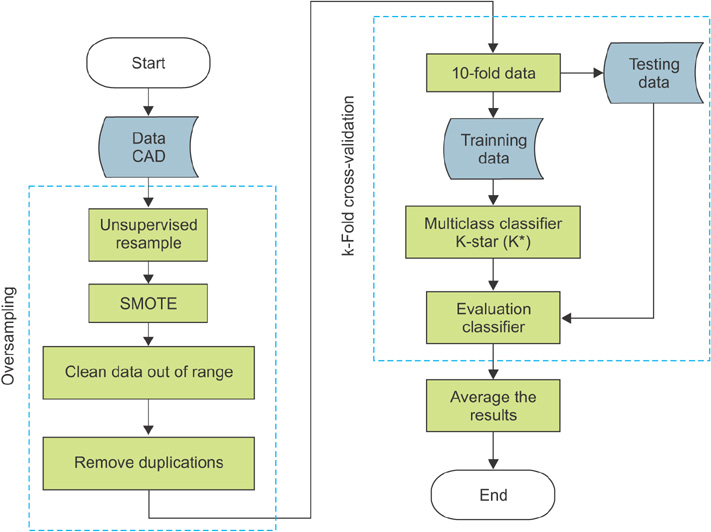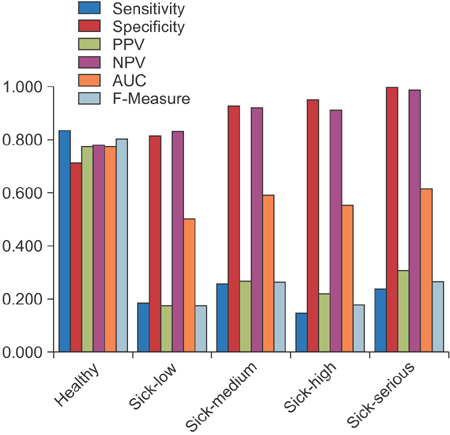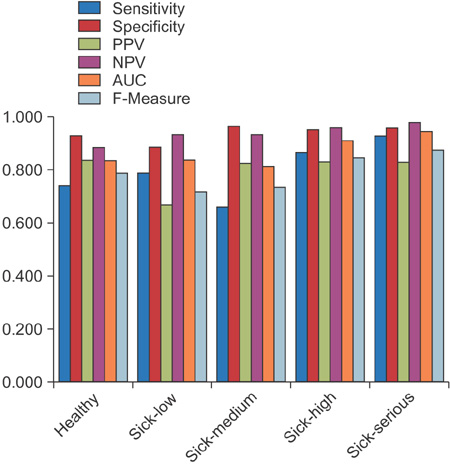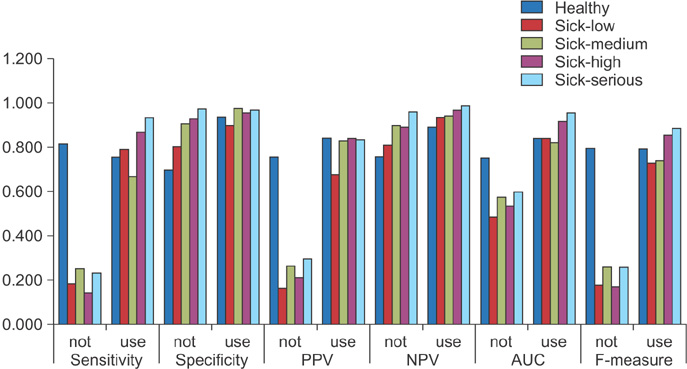Healthc Inform Res.
2016 Jan;22(1):30-38. 10.4258/hir.2016.22.1.30.
Intelligence System for Diagnosis Level of Coronary Heart Disease with K-Star Algorithm
- Affiliations
-
- 1Department of Informatic, Sebelas Maret University, Surakarta, Indonesia. wi_harto@yahoo.com
- 2Department of Biomedical Engineering, Gadjah Mada University, Yogyakarta, Indonesia.
- 3Department of Medichine, Gadjah Mada University, Yogyakarta, Indonesia.
- 4Department of Mechanical and Industrial Engineering, Gadjah Mada University, Yogyakarta, Indonesia.
- KMID: 2166914
- DOI: http://doi.org/10.4258/hir.2016.22.1.30
Abstract
OBJECTIVES
Coronary heart disease is the leading cause of death worldwide, and it is important to diagnose the level of the disease. Intelligence systems for diagnosis proved can be used to support diagnosis of the disease. Unfortunately, most of the data available between the level/type of coronary heart disease is unbalanced. As a result system performance is low.
METHODS
This paper proposes an intelligence systems for the diagnosis of the level of coronary heart disease taking into account the problem of data imbalance. The first stage of this research was preprocessing, which included resampled non-stratified random sampling (R), the synthetic minority over-sampling technique (SMOTE), clean data out of range attribute (COR), and remove duplicate (RD). The second step was the sharing of data for training and testing using a k-fold cross-validation model and training multiclass classification by the K-star algorithm. The third step was performance evaluation. The proposed system was evaluated using the performance parameters of sensitivity, specificity, positive prediction value (PPV), negative prediction value (NPV), area under the curve (AUC) and F-measure.
RESULTS
The results showed that the proposed system provides an average performance with sensitivity of 80.1%, specificity of 95%, PPV of 80.1%, NPV of 95%, AUC of 87.5%, and F-measure of 80.1%. Performance of the system without consideration of data imbalance provide showed sensitivity of 53.1%, specificity of 88,3%, PPV of 53.1%, NPV of 88.3%, AUC of 70.7%, and F-measure of 53.1%.
CONCLUSIONS
Based on these results it can be concluded that the proposed system is able to deliver good performance in the category of classification.
MeSH Terms
Figure
Cited by 2 articles
-
Interpretation of Clinical Data Based on C4.5 Algorithm for the Diagnosis of Coronary Heart Disease
Wiharto Wiharto, Hari Kusnanto, Herianto Herianto
Healthc Inform Res. 2016;22(3):186-195. doi: 10.4258/hir.2016.22.3.186.Detection of Cardiovascular Disease Risk's Level for Adults Using Naive Bayes Classifier
Eka Miranda, Edy Irwansyah, Alowisius Y. Amelga, Marco M. Maribondang, Mulyadi Salim
Healthc Inform Res. 2016;22(3):196-205. doi: 10.4258/hir.2016.22.3.196.
Reference
-
1. Kawamoto K, Houlihan CA, Balas EA, Lobach DF. Improving clinical practice using clinical decision support systems: a systematic review of trials to identify features critical to success. BMJ. 2005; 330(7494):765.
Article2. Isola R, Carvalho R, Tripathy AK. Knowledge discovery in medical systems using differential diagnosis, LAMSTAR & k-NN. IEEE Trans Inf Technol Biomed. 2012; 16(6):1287–1295.
Article3. Nakamura M, Kajiwara Y, Otsuka A, Kimura H. LVQ-SMOTE: Learning Vector Quantization based Synthetic Minority Over-sampling Technique for biomedical data. BioData Min. 2013; 6(1):16.4. Kim J, Lee J, Lee Y. Data-mining-based coronary heart disease risk prediction model using fuzzy logic and decision tree. Healthc Inform Res. 2015; 21(3):167–174.
Article5. Kim JK, Lee JS, Park DK, Lim YS, Lee YH, Jung EY. Adaptive mining prediction model for content recommendation to coronary heart disease patients. Cluster Comput. 2014; 17(3):881–891.
Article6. Selvarajah S, Kaur G, Haniff J, Cheong KC, Hiong TG, van der Graaf Y, et al. Comparison of the Framingham Risk Score, SCORE and WHO/ISH cardiovascular risk prediction models in an Asian population. Int J Cardiol. 2014; 176(1):211–218.
Article7. Das R, Turkoglu I, Sengur A. Effective diagnosis of heart disease through neural networks ensembles. Expert Syst Appl. 2009; 36(4):7675–7680.
Article8. Tu MC, Shin D, Shin D. Effective diagnosis of heart disease through bagging approach. Proceedings of 2nd International Conference on Biomedical Engineering and Informatics (BMEI'09). 2009 Oct 17-19; Tianjin, China. p. 1–4.9. Bashir S, Qamar U, YounusJaved M. An ensemble based decision support framework for intelligent heart disease diagnosis. Proceedings of 2014 International Conference on Information Society (i-Society). 2014 Nov 10-12; London. p. 259–264.10. Liu M, Wang Y, Dong X, Sun Q, Tan J. Improved BP algorithm and its application to intelligent diagnosis of coronary heart disease. Proceedings of 10th International Conference on Electronic Measurement & Instruments (ICEMI). 2011 Aug 16-19; Chengdu, China. p. 204–207.11. Rao BS, Rao KN, Setty SP. An approach for heart disease detection by enhancing training phase of neural network using hybrid algorithm. Proceedings of IEEE International Advance Computing Conference (IACC). 2014 Feb 21-22; Gurgaon, India. p. 1211–1220.12. Anooj PK. Clinical decision support system: risk level prediction of heart disease using weighted fuzzy rules. J King Saud Univ Comput Inform Sci. 2012; 24(1):27–40.
Article13. Anooj PK. Implementing decision tree fuzzy rules in clinical decision support system after comparing with fuzzy based and neural network based systems. Proceedings of International Conference on IT Convergence and Security (ICITCS). 2013 Dec 16-18; Macao. p. 1–6.14. Bhuvaneswari AN. An intelligent approach based on Principal Component Analysis and Adaptive Neuro Fuzzy Inference System for predicting the risk of cardiovascular diseases. Proceedings of Fifth International Conference on Advanced Computing (ICoAC). 2013 Dec 18-20; Chennai, India. p. 241–245.15. Lahsasna A, Ainon RN, Zainuddin R, Bulgiba A. Design of a fuzzy-based decision support system for coronary heart disease diagnosis. J Med Syst. 2012; 36(5):3293–3306.
Article16. Rajakumar BR, George A. On hybridizing fuzzy min max neural network and firefly algorithm for automated heart disease diagnosis. Proceedings of 4th International Conference on Computing, Communications and Networking Technologies (ICCCNT). 2013 Jul 4-6; Tiruchengode, India. p. 1–5.17. Ansari AQ, Gupta NK. Automated diagnosis of coronary heart disease using neuro-fuzzy integrated system. Proceedings of 2011 World Congress on Information and Communication Technologies. 2011 Dec 11-14; Mumbai, India. p. 1379–1384.18. Subanya B, Rajalaxmi RR. Feature selection using Artificial Bee Colony for cardiovascular disease classification. Proceedings of 2014 International Conference on Electronics and Communication Systems (ICECS). 2014 Feb 13-14; Coimbatore, India. p. 1–6.19. Zhang Y, Liu F, Zhao Z, Li D, Zhou X, Wang J. Studies on application of Support Vector Machine in diagnose of coronary heart disease. Proceedings of 6th International Conference on Electromagnetic Field Problems and Applications (ICEF). 2012 Jun 19-21; Dalian, China. p. 1–4.20. Mo Y, Xu S. Application of SVM based on hybrid kernel function in heart disease diagnoses. Proceedings of 2010 International Conference on Intelligent Computing and Cognitive Informatics (ICICCI). 2010 Jun 22-23; Kuala Lumpur, Malaysia. p. 462–465.21. Amma NB. Cardiovascular disease prediction system using genetic algorithm and neural network. Proceedings of 2012 International Conference on Computing, Communication and Applications (ICCCA). 2012 Feb 22-24; Dindigul, India. p. 1–5.22. Muthukaruppan S, Er MJ. A hybrid particle swarm optimization based fuzzy expert system for the diagnosis of coronary artery disease. Expert Syst Appl. 2012; 39(14):11657–11665.
Article23. Gomes Cabral G, de Oliveira AL. One-class classification for heart disease diagnosis. Proceedings of 2014 IEEE International Conference on Systems, Man and Cybernetics (SMC). 2014 Oct 5-8; San Diego, CA. p. 2551–2556.24. Muhammed LN. Using data mining technique to diagnosis heart disease. Proceedings of 2012 International Conference on Statistics in Science, Business, and Engineering (ICSSBE). 2012 Sep 10-12; Langkawi. p. 1–3.25. UCI Machine Learning Repository. Cleveland dataset (VA Medical Center, Long Beach and Cleveland Clinic Foundation: Robert Detrano, MD, PhD) [Internet]. Irvine: The University of California Irvine;1988. cited at 2016 Jan 8. Available from: https://archive.ics.uci.edu/ml/datasets/Heart+Disease.26. Salari N, Shohaimi S, Najafi F, Nallappan M, Karishnarajah I. A novel hybrid classification model of genetic algorithms, modified k-Nearest Neighbor and developed backpropagation neural network. PLoS One. 2014; 9(11):e112987.
Article27. Nahar J, Imam T, Tickle KS, Chen YP. Computational intelligence for heart disease diagnosis: a medical knowledge driven approach. Expert Syst Appl. 2013; 40(1):96–104.
Article28. Akrami S, Tabatabaee H, Raz NR. Application of computational intelligence in intensifying the accuracy of heart disease prognosis using a mutual validation. Indian J Fundam Appl Life Sci. 2014; 4(S4):1042–1053.29. Prabowo DW, Setiawan NA, Nugroho HA. A study of data randomization on a computer based feature selection for diagnosing coronary artery disease. Adv Intell Syst. 2014; 53:237–248.
Article30. Setiawan NA, Prabowo DW, Nugroho HA. Benchmarking of feature selection techniques for coronary artery disease diagnosis. Proceedings of 2014 6th International Conference on Information Technology and Electrical Engineering (ICITEE). 2014 Oct 7-8; Yogyakarta, Indonesia. p. 1–5.31. Choi JM. A selective sampling method for imbalanced data learning on support vector machines [dissertation]. Ames (IA): Iowa State University;2010.32. Chawla NV, Bowyer KW, Hall LO, Kegelmeyer WP. SMOTE: synthetic minority over-sampling technique. J Artif Intell Res. 2002; 16:321–357.
Article33. Painuli S, Elangovan M, Sugumaran V. Tool condition monitoring using K-star algorithm. Expert Syst Appl. 2014; 41(6):2638–2643.
Article34. Dominic V, Gupta D, Khare S. An effective performance analysis of machine learning techniques for cardiovascular disease. Appl Med Inform. 2005; 36(1):23–32.
- Full Text Links
- Actions
-
Cited
- CITED
-
- Close
- Share
- Similar articles
-
- Interpretation of Clinical Data Based on C4.5 Algorithm for the Diagnosis of Coronary Heart Disease
- Development of Algorithm for Nursing Interventions after Percutaneous Coronary Intervention
- Current Progress of Studies of Coronary CT for Risk Prediction of Major Adverse Cardiovascular Event (MACE)
- Diagnosis of coronary artery abnormalities in Kawasaki disease: recent guidelines and z score systems
- The Latest Trends in the Use of Deep Learning in Radiology Illustrated Through the Stages of Deep Learning Algorithm Development





